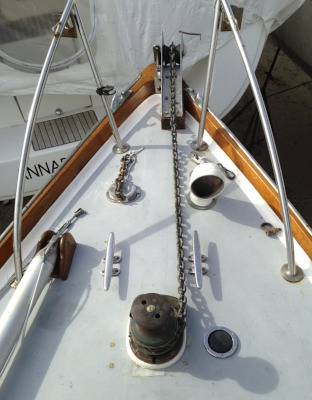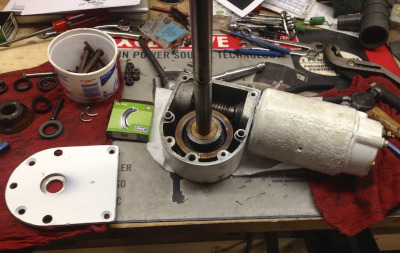Last updated: 2021 July 13
This page contains various methods employed by Alberg 35 owners to handle ground tackle aboard their boats. Hopefully you will see something that gives you an idea to meet your specific needs. Click on the photos to see larger images.
Bow Roller on Auriga, Hull #54
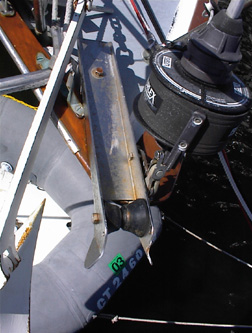 I have mounted an anchor davit on the starboard side of the stem fitting which holds the forestay (Furlex furler). The photo attached tries to give the details of mounting. The aft end of the davit shows the nut end of a bolt which goes thru a block of height to give a level mount with the surface of the toe rail. The bolt is secured inside by a plywood pad to distribute the load. (Click on the picture for a closer look.)
I have mounted an anchor davit on the starboard side of the stem fitting which holds the forestay (Furlex furler). The photo attached tries to give the details of mounting. The aft end of the davit shows the nut end of a bolt which goes thru a block of height to give a level mount with the surface of the toe rail. The bolt is secured inside by a plywood pad to distribute the load. (Click on the picture for a closer look.)
The stem fitting has three holes - does yours? The front hole is for the furler. I used the second hole to bolt the davit to the stem fitting with an appropriate spacer cut from a piece of bronze tubing. I think this shows in the photo.
The davit is stainless and has a brand name WindLine. I got it either from West Marine or Boat US. It is stainless, 300 series, non-magnetic. The same thing could be mounted on the port side for holding a second anchor.
Have stood out once or twice with 50 to 60 knot breezes with an ersatz plow with no problems. The rode is all chain to 100' and is hauled with a manual winch.
Hope this helps.
Bill Goward
AURIGA, Hull 54, 1962.
Bow Roller on Tomfoolery, Hull #212
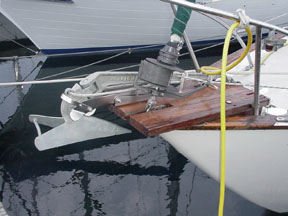 I wrestled with the optimal configuration of a bow roller for some time and decided to begin experimeting about a year ago. What you see is "Version 1.0" of Tomfoolery's bow roller system. (Click on the pictures for a closer look.)
I wrestled with the optimal configuration of a bow roller for some time and decided to begin experimeting about a year ago. What you see is "Version 1.0" of Tomfoolery's bow roller system. (Click on the pictures for a closer look.)
One goal of this prototype was to avoid making permanent changes to the configuration of the boat and foredeck, so the entire platform was raised up off the deck so that it would rest on the gunwales. Four 1/2-inch carriage bolts are used to through-bolt the platform to the foredeck. A temporary backing plate is used for the time being with the idea of glassing in something more permanent when I am satisfied with the configuration.
You may also notice that I had to move the bow fairleads aft about a foot to accomodate the platform. This change has made no significant impact on how the boat behaves when tied up to a slip or pier.
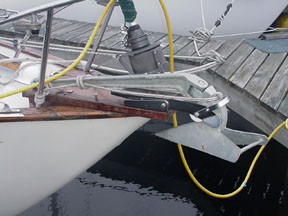 The platform and supports were made out of some ipe planks that were sawn into 1.5 inch wide strips and then laminated together with epoxy. The resulting board was then sanded smooth and varnished to match the finish of the boat. A slot was left in the center of the platform to accommodate the forestay and to allow for periodic removal for fine-tuning of the system. The anchor roller articulates on a hinge which theoretically makes it easier to deploy and retrieve an anchor. Not having a "standard" roller aboard makes this comparison difficult to substantiate.
The platform and supports were made out of some ipe planks that were sawn into 1.5 inch wide strips and then laminated together with epoxy. The resulting board was then sanded smooth and varnished to match the finish of the boat. A slot was left in the center of the platform to accommodate the forestay and to allow for periodic removal for fine-tuning of the system. The anchor roller articulates on a hinge which theoretically makes it easier to deploy and retrieve an anchor. Not having a "standard" roller aboard makes this comparison difficult to substantiate.
Ipe is an interesting wood. It is very dense (it won't float) and is almost impossible to work with hand tools. Because of this density it was felt that lag screws would be sufficient to hold the stainless steel roller to the platform. Unfortunately, I did not drill the pilot holes large enough and wound up shearing the heads off two of the bolts while tightening them down. I had to go back, drill out the screws, plug the holes and remount the roller in a slightly different location after this faux pas.
The platform was designed to extend beyond the bow just enough to prevent the flukes of the 33-lb plow from striking the hull during deployment, retrieval and when stowed. It also extends back onto the foredeck a minimal distance, taking up very little room. Prior to installing the platform, there was no roller at all and the ground tackle had to be manhandled up, around or through the bow pulpit. It's definitely much easier now.
What doesn't work well is the bail located over the roller that is supposed to keep the anchor rode from jumping out of the roller. It's a little undersized and the anchor has to be fed through at a specific angle to fit. While this adds some security against an accidental deployment, it does add inconvenience to retrieval. Also, the bail prevents using the roller in other functions, such as retrieving race marks at the end of the sailing season.
What's next? Adding a second roller. The next one will not be an articulating model in order to keep the cost down. Also, if there is a bail over the roller, it will be removable so that the roller can be used for multiple purposes. I'm half tempted to fabricate a roller using a roller designed for use on boat trailers, providing I can find a suitable way of attaching it to the platform. I'll keep you posted.
Tom Alley
Tomfoolery, Hull 212, 1965.
Effie - Hull #239
This is how we handle our 35 lb. Danforth Plow. The windlass is an old electric Nilsson that I overhauled and installed a few years ago.
Paul Dunn
Effie, Hull 239





